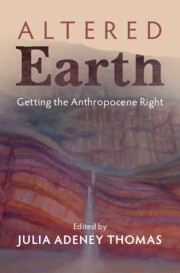Book contents
- Altered Earth
- Altered Earth
- Copyright page
- Dedication
- Contents
- Figures
- Foreword
- Acknowledgments
- Introduction: The Growing Anthropocene Consensus
- Part One Strata and Stories
- Part Two One Anthropocene; Many Stories
- Chapter 3 Earth System Science: Gravity, the Earth System, and the Anthropocene
- Chapter 4 Deep History and Disease: Germs and Humanity’s Rise to Planetary Dominance
- Chapter 5 Anthropology: Colonialism, Indigeneity, and Wind Power in the Anthropocene
- Chapter 6 The Ascent of the Anthropoi: A Story
- Chapter 7 Politics in the Anthropocene
- Chapter 8 Very Recent History and the Nuclear Anthropocene
- Chapter 9 Stratigraphy: Finding Global Markers in a Small Canadian Lake
- Chapter 10 Curating the Anthropocene at Berlin’s Haus der Kulturen der Welt
- Part Three Future Habitations
- Biographies of Chapter Contributors
- Index
- References
Chapter 3 - Earth System Science: Gravity, the Earth System, and the Anthropocene
from Part Two - One Anthropocene; Many Stories
Published online by Cambridge University Press: 24 March 2022
- Altered Earth
- Altered Earth
- Copyright page
- Dedication
- Contents
- Figures
- Foreword
- Acknowledgments
- Introduction: The Growing Anthropocene Consensus
- Part One Strata and Stories
- Part Two One Anthropocene; Many Stories
- Chapter 3 Earth System Science: Gravity, the Earth System, and the Anthropocene
- Chapter 4 Deep History and Disease: Germs and Humanity’s Rise to Planetary Dominance
- Chapter 5 Anthropology: Colonialism, Indigeneity, and Wind Power in the Anthropocene
- Chapter 6 The Ascent of the Anthropoi: A Story
- Chapter 7 Politics in the Anthropocene
- Chapter 8 Very Recent History and the Nuclear Anthropocene
- Chapter 9 Stratigraphy: Finding Global Markers in a Small Canadian Lake
- Chapter 10 Curating the Anthropocene at Berlin’s Haus der Kulturen der Welt
- Part Three Future Habitations
- Biographies of Chapter Contributors
- Index
- References
Summary
This piece takes the reader on a virtual trip through the Earth System, using visualisations as a key tool to understand our home planet and our evolving knowledge about it. It begins and ends with trips between the Earth’s surface and space, experiencing the Earth System from above. In between, however, we take an historical tour of the planet, tracking the evolution of humanity’s growing understanding of the Earth and how it functions as a system. The tour wanders through the evolving scientific landscape, beginning with the famous ‘Blue Marble’ image of Earth taken by the Apollo 11spacecraft in 1972, continuing with James Lovelock’s Gaia hypothesis and John Schellnhuber’s second Copernican revolution, and finishing with Paul Crutzen’s confronting assertion that the Earth System is now in the Anthropocene, leaving humanity’s comfort zone of the Holocene as a receding memory.
Keywords
- Type
- Chapter
- Information
- Altered EarthGetting the Anthropocene Right, pp. 83 - 105Publisher: Cambridge University PressPrint publication year: 2022
References
- 3
- Cited by

